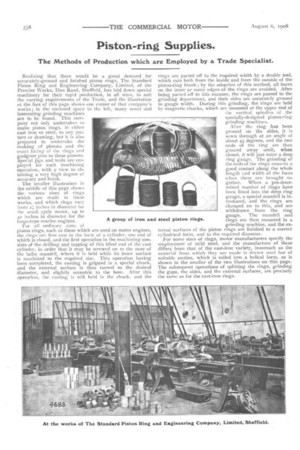Piston-ring Supplies.
Page 16

If you've noticed an error in this article please click here to report it so we can fix it.
The Methods of Production which are Employed by a Trade Specialist.
Realising that there would be a great demand for accurately-ground and finished piston rings, The Standard Piston Ring and Engineering Company, Limited, of the Premier Works, Don Road, Sheffield, has laid down special machinery for their rapid production, in all sizes, to suit the varying requirements of the Trade, and the illustration at the foot of this page shows one corner of that company's works; in the enclosed space to the left, many novel and interesting grinding machines are to be found. This cornpany not only undertakes to make piston rings, in either cast iron or steel, to any pattern or drawing, but it is also prepared to undertake the making of pistons and the exact fitting of the rings and gudgeon pins to these pistons. Special jigs and tools are employed for each Machining operation, with a view to obtaining a very high degree of accuracy and finish.
The smaller illustration in the middle of this page shows the various sizes of rings which are made in these works, and which rings vary from 22; inches in diameter for the small cycle motor, up to 42 inches in diameter for the large-type marine engines.
For all ordinary sizes of piston rings, such as those which are used on motor engines, the rings are first cast in the form of a cylinder, one end of which is closed, and the first operation in the machining consists of the drilling and tapping of this blind end of the cast cylinder, in order that it may be screwed on to the nose of the lathe mandril, where it is held while its inner surface is machined to the required size. This operation having been completed, the casting is gripped in a special chuck, and the external surface is then turned to the desired diameter, and slightly eccentric to the bore. After this operation, the casting is still held in the chuck, and the rings are parted off to the required width by a double tool, which cuts both from the inside and from the outside of the piston-ring blank ; by the adoption of this method, all burrs on the inner or outer edges of the rings are avoided. After being parted off in this manner, the rings are passed to the grinding department, and their sides are accurately ground to gauge width. During this grinding, the rings are held by magnetic chucks, which are mounted at the upper end of the vertical spindles of the specially-designed piston-ring grinding machines, After the ring has been ground on the sides, it is sawn through at an angle of about 45 degrees, and the two ends of the ring are then ground away until, when closed, it will just enter a deep ring gauge. The grinding of the ends of the rings ensures a good contact along the whole length and width of the faces when these are brought together. When a pre-determined number of rings have been fitted into the deep ring gauge, a special mandril is in_ troduced, and the rings are clamped on to this, and are withdrawn from the ring gauge. The mandril and rings are then mounted in a grinding machine, and the external surfaces of the piston rings are finished to a correct cylindrical form, and to the required diameter. For some sizes of rings, motor manufacturers specify the employment of mild steel, and the manufacture of these differs from that of the cast-iron variety, inasmuch as the material from which they are made is drawn steel bar of suitable section, which is rolled into a helical form, as is shown in the smaller of the two illustrations on this page. The subsequent operations of splitting the rings, grinding the gaps, the sides, and the external surfaces, are precisely the same as for the cast-iron rings.


















